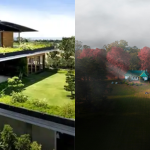In the quest for sustainability and energy efficiency, one critical yet often overlooked factor is the role of air leakage in buildings. Not only does excessive air infiltration lead to higher energy bills, but it also impacts comfort levels, indoor air quality, and environmental footprint. This comprehensive guide explores the significance of minimizing air leakage and offers practical strategies for achieving sealing success, ultimately enhancing energy efficiency and promoting a more sustainable future.
Understanding Air Leakage
Air leakage occurs when outside air enters and conditioned air leaves your building uncontrollably through cracks and openings. While some ventilation is necessary for air quality, too much can be detrimental, affecting both energy consumption and comfort. In winter, warm air escaping from a building requires more heating to maintain comfort; similarly, in summer, cooling systems work harder to compensate for hot air intrusion.
The Impact of Air Leakage
- Increased Energy Consumption: Uncontrolled air leakage can account for a significant portion of a building’s heating and cooling costs.
- Reduced Comfort: Drafts and uneven temperatures caused by air leakage lead to discomfort for occupants.
- Diminished Indoor Air Quality: Excess airflow can carry pollutants and allergens into the building.
Strategies for Minimizing Air Leakage
Achieving sealing success involves a holistic approach that includes identifying leakage points, selecting appropriate sealing methods, and considering the building’s overall ventilation needs. Here are key strategies to enhance energy efficiency through effective air sealing:
1. Conduct an Energy Audit
The first step in minimizing air leakage is identifying where it occurs. An energy audit, particularly a blower door test, can quantify air leakage and pinpoint specific leaks. This assessment provides a baseline for improvement and helps prioritize sealing efforts.
2. Seal Gaps and Cracks
Common leakage points include windows and doors, attic hatches, wiring and plumbing penetrations, and where walls meet floors and ceilings. Use caulk and weatherstripping for smaller gaps and expanding foam or rigid materials for larger openings.
- Windows and Doors: Apply weatherstripping around movable components and caulk any gaps in the framing.
- Attics and Basements: Ensure that access points are properly sealed. Use rigid foam insulation and sealant around openings for pipes and ducts.
- Exterior Walls: Inspect for cracks and holes, particularly near utility entrances, and seal them with appropriate materials.
3. Improve Insulation
Enhancing insulation not only reduces heat transfer but also minimizes airflow between the inside and outside. Pay particular attention to attics, basements, and crawl spaces, where air leakage can be substantial. Properly insulating these areas can significantly impact overall energy efficiency.
4. Ensure Proper Ventilation
While sealing your building against air leaks, it’s crucial to maintain adequate ventilation for indoor air quality. Incorporate controlled ventilation systems, such as energy recovery ventilators (ERVs) or heat recovery ventilators (HRVs), which provide fresh air while minimizing energy loss.
5. Upgrade Windows and Doors
If windows and doors are old and inefficient, consider replacing them with energy-efficient models designed to reduce air leakage. Look for products with the ENERGY STAR® rating, which meet strict energy efficiency guidelines set by the U.S. Environmental Protection Agency.
6. Address Duct Leakage
In forced-air heating and cooling systems, ducts that move air to and from a central air conditioner or furnace can be significant sources of air leakage. Seal all ductwork using mastic sealant or metal tape and insulate ducts that run through unheated spaces to prevent energy loss.
7. Custom HVAC Dampers
Custom HVAC dampers are vital for optimizing airflow and minimizing leakage in HVAC systems. They adjust to control air volume, enhance energy efficiency, and improve comfort in buildings. Fine-tuning these dampers directs air where needed, reduces HVAC demand, and prevents conditioned air loss. They are key to better indoor climate control and significantly cut energy consumption by distributing air precisely.
Monitoring and Maintenance for Long-Term Success
Achieving sealing success is not a one-time effort but requires ongoing monitoring and maintenance. Regularly check seals and insulation for gaps or deterioration and address any issues promptly. Consider conducting periodic energy audits to identify new leaks or opportunities for further improvements.
The Benefits of Sealing Success
Minimizing air leakage through effective sealing brings multiple benefits:
- Lower Energy Bills: Reduced air leakage means less energy is needed to heat or cool the building, leading to significant savings.
- Enhanced Comfort: Eliminating drafts and maintaining consistent temperatures improves comfort levels for occupants.
- Improved Indoor Air Quality: Controlling air flow allows for better management of air filtration, reducing the intrusion of outdoor pollutants.
- Environmental Protection: Lower energy consumption reduces greenhouse gas emissions, contributing to environmental sustainability.
Conclusion
Sealing success in minimizing air leakage is a key component of enhancing energy efficiency in buildings. By identifying leakage points, employing effective sealing and insulation techniques, and ensuring proper ventilation, building owners can achieve significant energy savings, improve occupant comfort, and make strides towards a more sustainable future. Remember, the path to energy efficiency is not just about the big changes; sometimes, it’s the cracks and gaps that matter the most.



